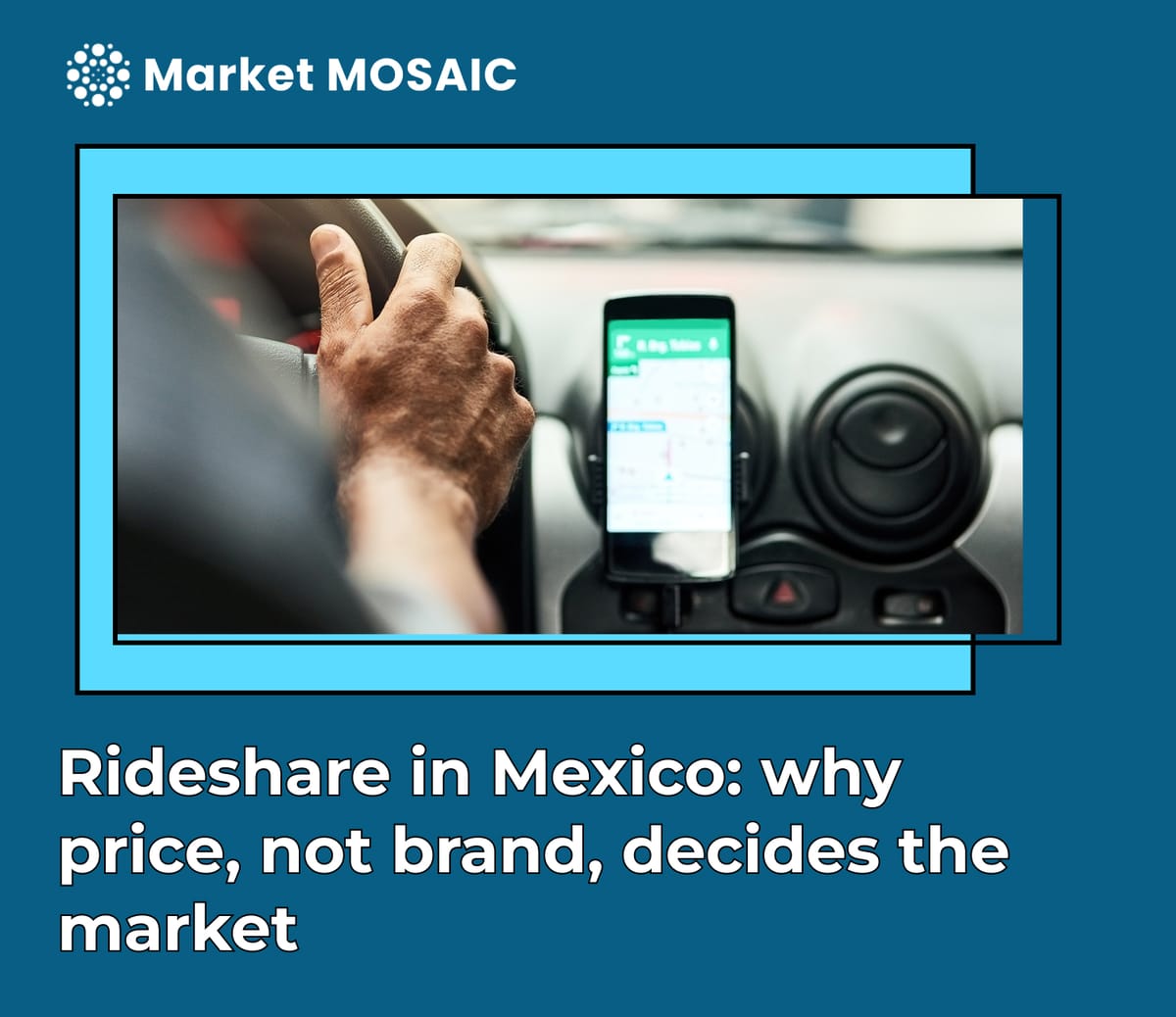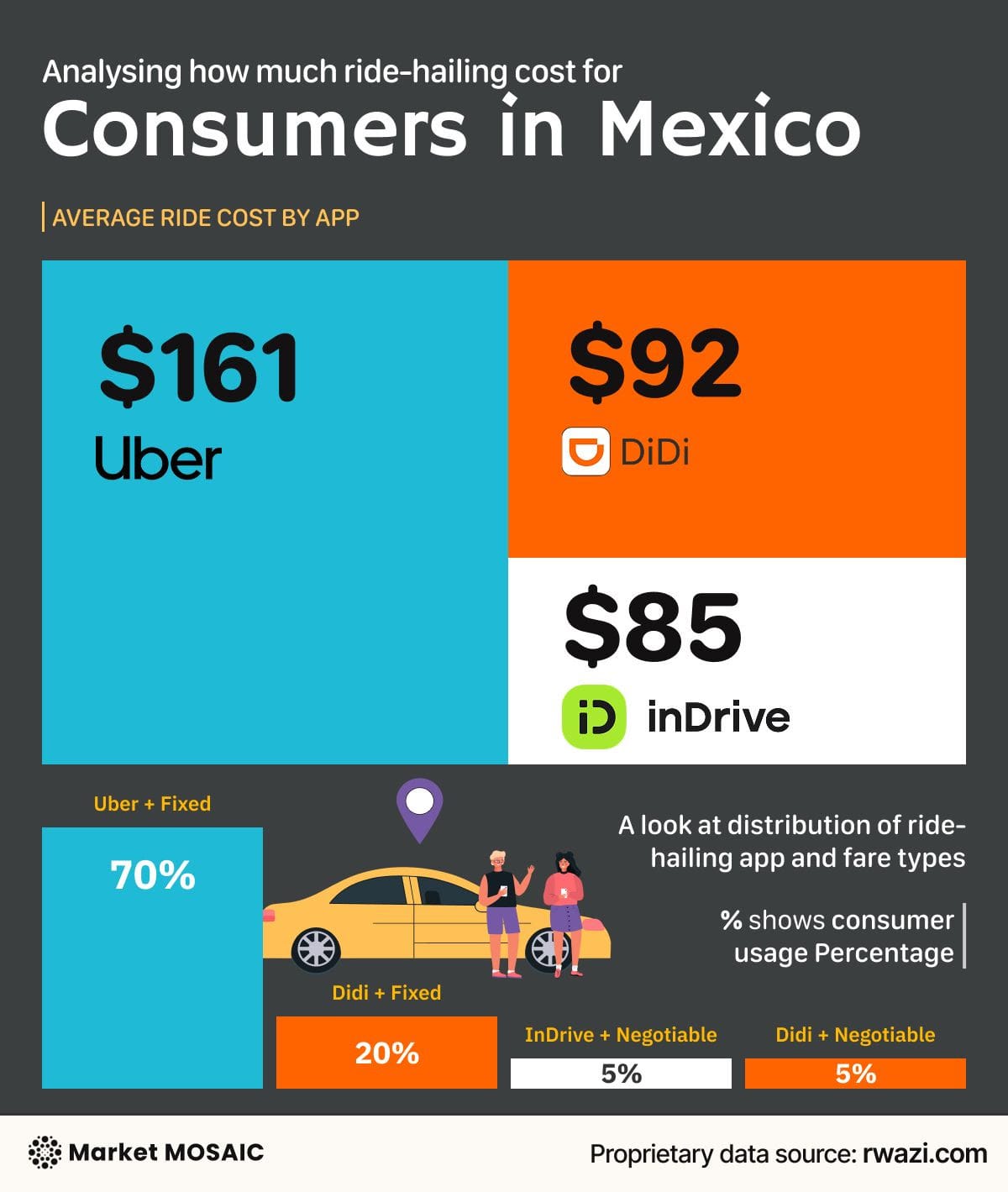Rideshare in Mexico: why price, not brand, decides the market

The market landscape
Step into the streets of Mexico City at rush hour and you’ll see just how central ridesharing has become to everyday life. From office workers trying to beat the evening rain to students splitting the cost of a late-night ride, apps like Uber, DiDi, and InDrive have become part of the city’s rhythm. The Mexican rideshare market is no small player, it’s valued at US$3.3 to US$4.5 billion, making it one of the largest in Latin America. In fact, the competition is so fierce that Cabify, once a recognizable name on the streets, exited Mexico in 2024, unable to keep pace with the pressure from rivals.
Yet behind the convenience lies a bigger story: price. With household incomes averaging MX$25,955 per month and inflation running at about 4–4.5 percent, Mexican families are watching their pesos closely. That makes ridesharing less about loyalty to one brand and more about finding the best deal in the moment.
Competing strategies: Uber, DiDi, and InDrive
Each platform has carved out its own strategy. Uber has leaned heavily on its reputation for safety and reliability, charging an average of MX$161 per trip. Riders who stick with Uber are often buying peace of mind. DiDi, on the other hand, has gone for scale with affordability, keeping average fares closer to MX$85 and offering a mix of fixed and negotiable pricing. Then there’s InDrive, the disruptor, with its “name-your-price” model that lets passengers propose a fare before the ride begins. At about MX$92 per trip, InDrive’s model gives consumers a sense of agency that resonates in a market where every peso counts.

Together, these three companies illustrate a spectrum of choices: Uber as the premium option, DiDi as the budget-conscious alternative, and InDrive as the platform that hands pricing power directly to the rider.
What our data reveals
Rwazi propriety data highlights just how deeply ridesharing is embedded in daily life. More than half of riders take at least six trips a month, showing that this isn’t an occasional luxury but a regular habit. Yet habits don’t necessarily mean loyalty. Around 31 percent of riders switch between apps regularly, comparing fares before committing to a trip.
Pricing explains much of this behavior. Fixed fares account for nearly 79 percent of rides, but the remaining 21 percent that involve negotiation have become a playground for inDrive. Riders who embrace negotiation feel like they’re getting a better deal, even if the savings are small. And yet, Uber’s strength persists. Despite being almost twice as expensive as DiDi, Uber still captures 70 percent of fixed-fare rides, proof that many consumers are willing to pay more if it guarantees speed, safety, and reliability.
Why this matters for business leaders
For business leaders in this industry, loyalty is fragile. Riders are loyal to value, not brands. That means the companies that thrive will be those that find ways to make switching less attractive, whether through loyalty credits, transparent surge pricing, or service guarantees that justify higher fares. DiDi’s hybrid approach, blending affordability with flexibility, shows how price innovation can attract diverse consumer groups. InDrive’s negotiation-first model proves that giving customers a sense of control is more than a gimmick, it’s a powerful loyalty tool in a market shaped by inflation and economic caution.
Even investors are paying attention. DiDi has committed US$410 million to its Latin American operations, showing how seriously it takes this battleground. That level of investment suggests more promotions, more incentives for drivers, and an even tougher challenge for Uber’s premium strategy.
The future of ridesharing in Mexico will not be decided by brand campaigns alone. It will be won by the platforms that treat pricing as a living system—responsive to inflation, competition, and consumer expectations. For riders, it’s simple: they’ll keep switching until they find the right balance of price and reliability. For companies, the challenge will be to deliver trust without losing sight of affordability, and to innovate without eroding the very margins that make the business sustainable.





